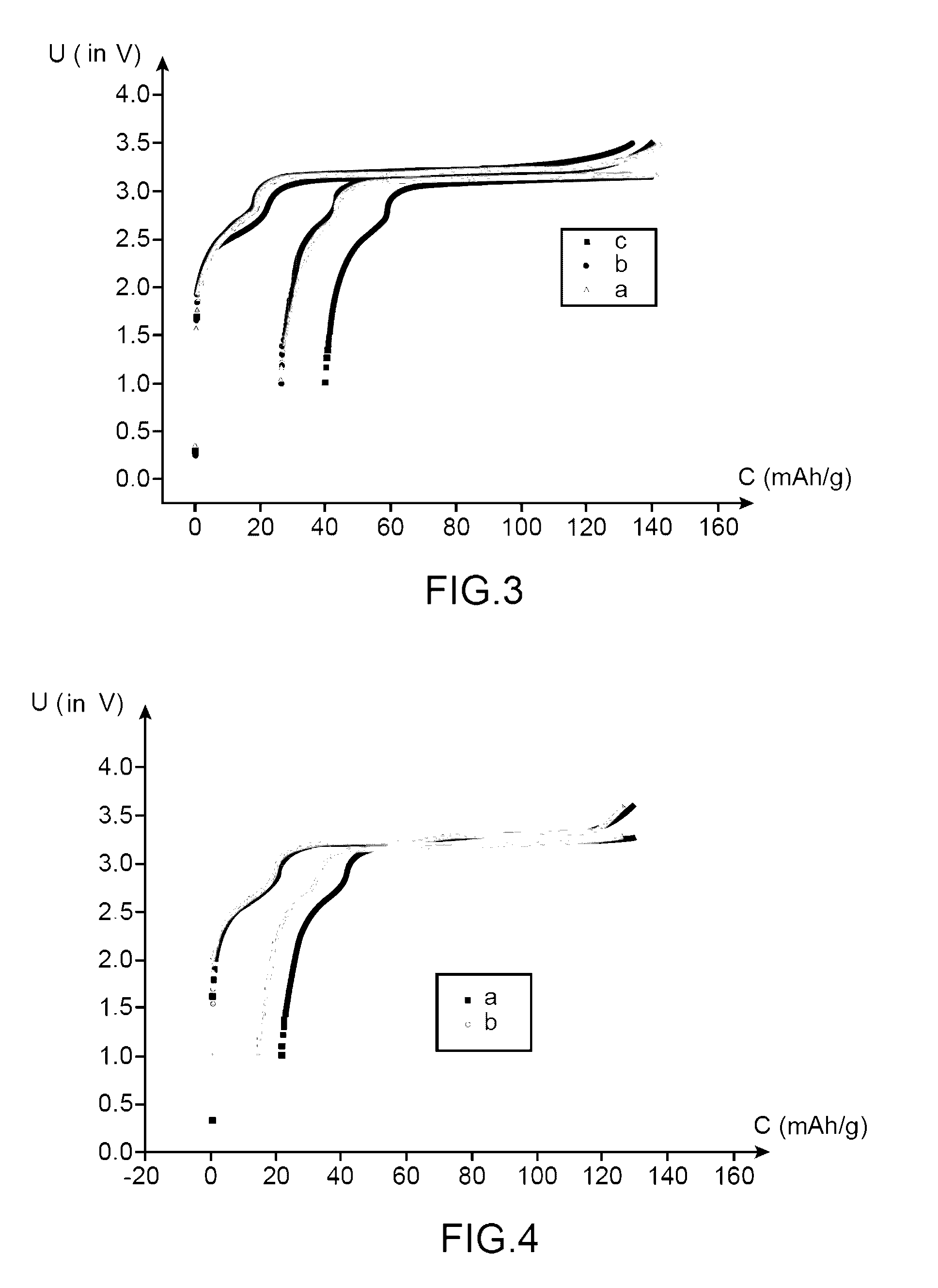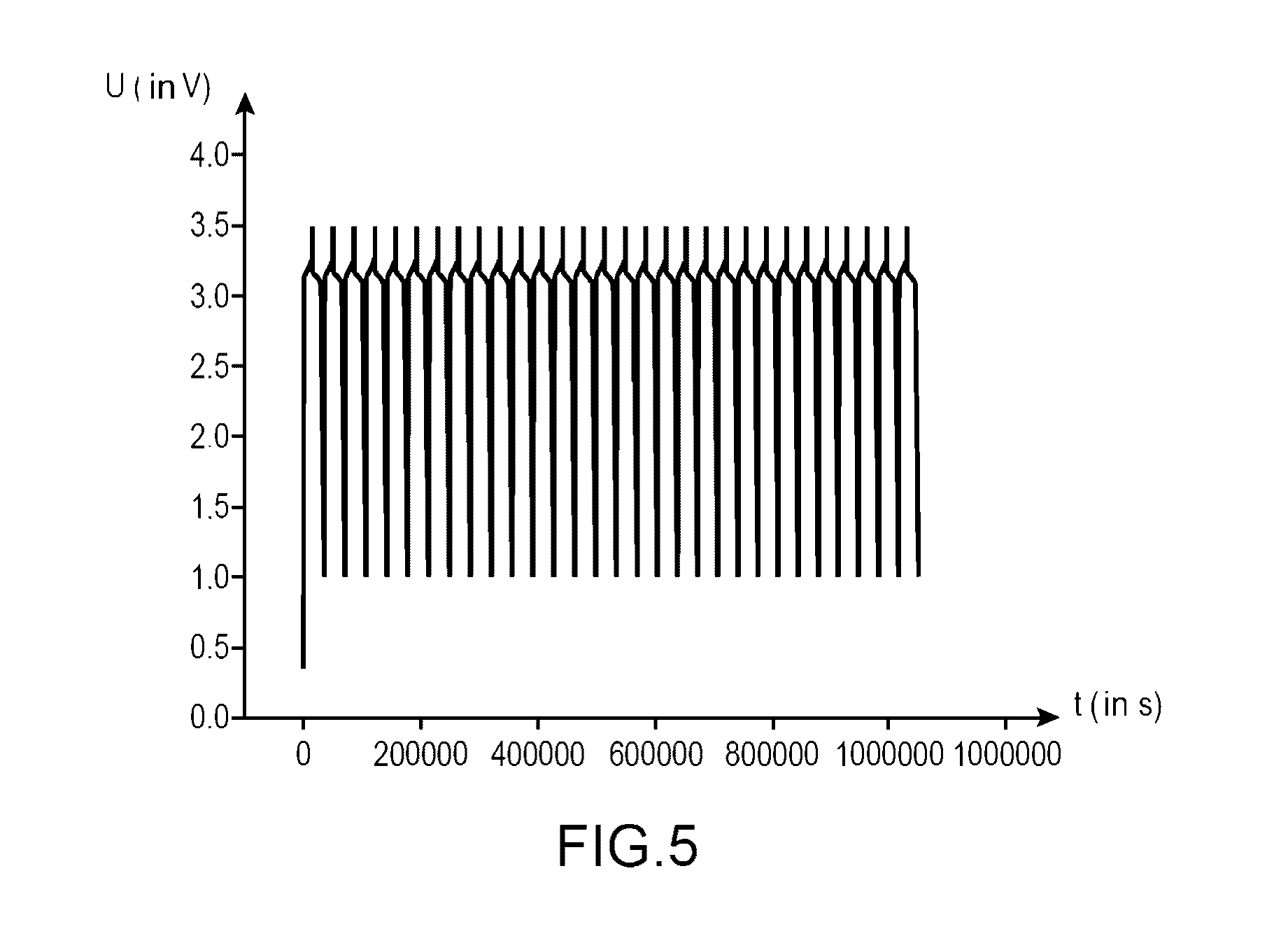Specific lithium batteries comprising non-aqueous electrolytes based on sulfone compounds
a technology of specific lithium batteries and sulfone compounds, which is applied in the direction of electrolytes, cell components, organic electrolytes, etc., can solve the problem of restricting its use as a single solvent, and achieve excellent coulomb efficiency and stability to oxidation phenomena
- Summary
- Abstract
- Description
- Claims
- Application Information
AI Technical Summary
Benefits of technology
Problems solved by technology
Method used
Image
Examples
example 1
[0136]This example, with a comparative goal, has the purpose of comparing the performances:[0137]of a lithium-ion battery using an electrolyte according to the invention (i.e., an electrolyte comprising a mixture of ethylmethylsulfone (symbolized subsequently by EMS) and of dimethyl carbonate (symbolized subsequently by DMC) (in mass proportions 1:1) comprising LiPF6 1M and 1% by mass of succinic anhydride (symbolized subsequently by AS); and
[0138]of a lithium-ion battery using an electrolyte non-compliant with the invention (i.e., an electrolyte comprising a mixture of ethylmethylsulfone (symbolized subsequently by EMS) and of dimethyl carbonate (symbolized subsequently by DMC) (in mass proportions 1:1) comprising LiPF6 1M and 1% by mass of vinylene carbonate (symbolized, subsequently by VC).
[0139]The presentation of this example is divided into three portions:
[0140]1∘) Preparation of the electrolyte according to the invention and of the battery comprising it;
[0141]2∘) Preparation ...
example 2
[0170]This example, with a comparative intention, has the purpose of comparing the performances:[0171]of a lithium-ion battery using an electrolyte according to the invention (i.e., an electrolyte comprising a mixture of ethylmethylsulfone (symbolized, subsequently, by EMS) and of dimethyl carbonate (symbolized, subsequently by DMC) in mass proportions comprising LiPF6 1M and 1% of succinic anhydride (symbolized, subsequently by AS); and[0172]of a lithium-ion battery using an electrolyte not compliant with the invention (i.e., an electrolyte comprising a mixture of ethylmethylsulfone (symbolized, subsequently by EMS) and of dimethyl carbonate (symbolized, subsequently by DMC) (in mass proportions 1:1) comprising LiPF6 1M.
[0173]The battery according to the invention is prepared in the same way as the one of example 1.
[0174]The battery not compliant with the invention is prepared in the same way as the battery according to the invention, except that it is not proceeded with the additi...
example 3
[0178]This example with a comparative intention, has the purpose of comparing the performances:[0179]of a first lithium-ion battery using an electrolyte according to the invention (i.e., an electrolyte comprising a mixture of ethylmethylsulfone (symbolized, subsequently, by EMS) and of dimethyl carbonate (symbolized, subsequently, by DMC) (in mass proportions 1:1) comprising LiPF6 1M and 1% by mass of succinic anhydride (symbolized, subsequently, by AS);[0180]of a second lithium-ion battery using an electrolyte according to the invention (i.e., an electrolyte comprising a mixture of ethylmethylsulfone (symbolized, subsequently by EMS) and of dimethyl carbonate (symbolized, subsequently by DMC) (in mass proportions 1:1) comprising LiPF6 1M and 0.1% by mass of succinic anhydride (symbolized, subsequently by AS); and[0181]of a lithium-ion battery using an electrolyte not compliant with the invention (i.e., an electrolyte comprising a mixture of ethylmethylsulfone (symbolized, subsequen...
PUM
 Login to View More
Login to View More Abstract
Description
Claims
Application Information
 Login to View More
Login to View More - R&D
- Intellectual Property
- Life Sciences
- Materials
- Tech Scout
- Unparalleled Data Quality
- Higher Quality Content
- 60% Fewer Hallucinations
Browse by: Latest US Patents, China's latest patents, Technical Efficacy Thesaurus, Application Domain, Technology Topic, Popular Technical Reports.
© 2025 PatSnap. All rights reserved.Legal|Privacy policy|Modern Slavery Act Transparency Statement|Sitemap|About US| Contact US: help@patsnap.com



